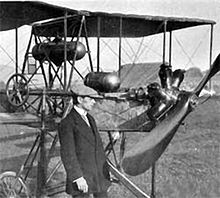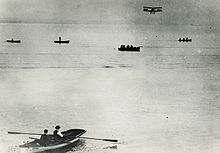Dufaux 4
| Dufaux 4 | |
|---|---|
 The "Dufaux 4", March 25, 1911 |
|
| Type: | |
| Design country: | |
| Manufacturer: |
Armand and Henri Dufaux |
| First flight: |
December 16, 1909 |
| Number of pieces: |
15th |
The Dufaux 4 is a single-seat aircraft from the French - Swiss aviation pioneers Henri and Armand Dufaux .
Construction and development
The Dufaux 4 was designed by the brothers Henri and Armand Dufaux as a biplane , offered space for the pilot and differed little from comparable designs - two wings, triangular fuselage cross-section - from the pioneering years of motorized aviation. It was an experimental aircraft and a further development of the unnamed Model 2 with eight wings and a three-decker built by the brothers (Model 3).
The double-decker was designed within a few weeks from mid-September 1909 - the brothers hoped that their design would win the prize money of 1,000 Swiss francs awarded by the Swiss Automobile Club (ACS) for the first closed-loop aircraft built in Switzerland One kilometer in diameter.
The three-cylinder Anzani aircraft engine of the "Traversée de la Manche" type ordered on October 5, 1909 was delivered in November - too late to take part in the ACS competition. At the beginning of December, the brothers began test flights in the area around Corsier near Geneva . The machine took off briefly from the ground, but flew only a few meters. The Dufaux 'suspected that the take-off distance was too short and relocated their flight attempts to a larger meadow near Viry . On December 16, 1909, they continued the test flights, and they achieved their first successful flights in the afternoon of the same day. The next day brought repeated problems when taking off: After Henri Dufaux was the launch succeeded, he brought the plane in about 15 meters altitude for coating and touched with the left wing to the ground. He survived the crash unharmed, but the wings and the propeller were badly damaged; however, the engine could continue to be used. The brothers immediately repaired the machine in order to demonstrate it on the occasion of the flight meeting in Colombier from January 9th to 11th, 1910. They could not start because of the bad weather, but received their first orders for the double-decker, now known as the Dufaux 4 . In June and July 1910 Armand and Henri Dufaux achieved successful flights of eight kilometers, on July 10th of 23 kilometers, crowned by a 31-minute flight on July 12th, 1910.
use
At the end of 1909, the automobile pioneers Perrot Duval announced a prize money of an impressive 5,000 Swiss francs at the time to promote aviation development .
On August 28, 1910, Armand took off at 5:45 a.m. from Noville / St. Gingolph and flew not far from the south bank at an altitude of around 50 meters over Lake Geneva to Geneva - he covered the 66-kilometer flight in 56 minutes and 5 seconds. With this pioneering achievement, Armand Dufaux had dared the world's longest flight over open water and won the prize money of the Perrot Duval Prize for crossing Lake Geneva along its entire length.
In the months after the record flight of August 28, 1910, the Dufaux brothers undertook numerous other flights and participated with other aviation pioneers - including Pierre Emile Taddéoli (1879–1920), flying boat pioneer and chief pilot of the later Ad Astra Aero until 1920 - at flight meetings that took them to the USA.
The Swiss military had already rejected the use of the Dufaux 4 in May 1910 because those responsible found it unsuitable for military use. The improved biplane Dufaux 5 led Ernest Failloubaz (1892-1919) - 19 years old at the time the youngest pilot in Switzerland - from 4 to 6 September 1911 the Swiss army before by the with his friend Gustave Lecoultre as observers in the maneuvers 1st Army Corps flew reconnaissance missions. Despite a crash landing on the last day of the three-day mission, these flights mark the beginning of Swiss military aviation .
Technical specifications
| Parameter | Data |
|---|---|
| crew | 1 pilot |
| length | 9.5 m |
| height | 2.7 m |
| span | 8.5 m |
| Wing area | 24.0 m² |
| Empty mass | 180 kg |
| Max. Takeoff mass | 320 kg |
| drive | an Anzani engine with 19 kW (25 hp) at 1400 rpm |
| Start speed | 42 km / h |
| Top speed | 60 km / h |
| Service ceiling | 500 m |
variants


Also on Lake Geneva in December 1910, a Dufaux 4 (M) was tested as a seaplane with a central swimmer positioned across the direction of flight . In addition to the Anzani engine, the Dufaux 4 was equipped with aircraft engines from Gnôme et Rhône and the 8-cylinder V-engine Antoinette ENV ; the latter version can be seen in the Swiss Museum of Transport in Lucerne. The total number of aircraft produced needs clarification, but together with the Dufaux 5 it should have been at least 15 aircraft.
The Dufaux 4 today
On August 28, 2010, Armand Dufaux's pioneering feat was to be repeated and the Swiss astronaut Claude Nicollier to fly over Lake Geneva along the historic route from 1910. For the 100th anniversary of the flight, the “Faux Dufaux” working group rebuilt the Dufaux 4, the oldest surviving Swiss aircraft, on display in the Museum of Transport. A total of around 3,000 helpers - private individuals, lecturers, apprentices and students - from ETH Lausanne , vocational schools in western Switzerland took part in the project, which had a budget of 4.7 million Swiss francs .
However, the Swiss Federal Office for Civil Aviation (FOCA) has so far refused to approve the replica and has demanded that essential parts be redesigned. In September 2011, Nicollier stated that he wanted to use his good relationships with the FOCA to get the Dufaux replica off the ground.
See also
literature
- Michael JH Taylor: Jane's Encyclopedia of Aviation. P. 347, Studio Editions, London 1989.
Web links
- The Dufaux 4 in pionnair-ge (French)
- Pionniers de l'aéronautique à Genève on pionnair-ge with a detailed description of the flight of August 28, 1910 and photos (French)
- Henri and Armand Dufaux in pionnair-ge (French)
Individual evidence
- ^ Website of Perrot Duval Holding AG: Summary of the history of Perrot Duval Holding AG ( PDF 836 kB), accessed on December 24, 2008
- ↑ Pierre Emile Taddéoli in pionnair-ge (French)
- ^ Official website of the Swiss Air Force: The first Swiss military flight ( Memento from August 14, 2011 in the Internet Archive ), accessed on December 24, 2008
- ↑ The «Dufaux 4» seaplane on pionnair-ge with information on testing and photos (French)
- ↑ The “Dufaux 4” in the Swiss Museum of Transport in Lucerne ( memento of July 7, 2011 in the Internet Archive ), accessed on December 23, 2008
- ↑ Tages-Anzeiger (December 23, 2008): Replica of Switzerland's oldest aircraft - Nicollier piloted , accessed on December 23, 2008
- ↑ LeTemps.ch (September 28, 2011): Le “FauXDufauX” cloué au sol , accessed on November 7, 2011, not freely accessible

